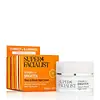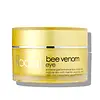What's inside
What's inside
 Key Ingredients
Key Ingredients

 Benefits
Benefits

 Concerns
Concerns

 Ingredients Side-by-side
Ingredients Side-by-side

Water
Skin ConditioningCyclopentasiloxane
EmollientGlycerin
HumectantCetyl Alcohol
EmollientIsostearyl Isostearate
EmollientPolyacrylate-13
Butyrospermum Parkii Butter
Skin ConditioningPentaerythrityl Distearate
EmulsifyingPhenoxyethanol
PreservativePolyisobutene
Sodium Ascorbyl Phosphate
AntioxidantParfum
MaskingSodium Stearoyl Glutamate
CleansingAllantoin
Skin ConditioningBenzoic Acid
MaskingDisodium EDTA
Polysorbate 20
EmulsifyingPropylene Glycol
HumectantSodium Polyacrylate
AbsorbentSorbitan Isostearate
EmulsifyingSolanum Lycopersicum Fruit Extract
AntioxidantDehydroacetic Acid
PreservativeCitric Acid
BufferingLimonene
PerfumingEmblica Officinalis Fruit Extract
Skin ConditioningSodium Hyaluronate
HumectantTocopheryl Acetate
AntioxidantGlyceryl Acrylate/Acrylic Acid Copolymer
HumectantCitral
PerfumingButylphenyl Methylpropional
PerfumingGlycyrrhiza Glabra Root Extract
BleachingHydroxycitronellal
PerfumingHydroxyisohexyl 3-Cyclohexene Carboxaldehyde
MaskingLinalool
PerfumingTromethamine
BufferingWater, Cyclopentasiloxane, Glycerin, Cetyl Alcohol, Isostearyl Isostearate, Polyacrylate-13, Butyrospermum Parkii Butter, Pentaerythrityl Distearate, Phenoxyethanol, Polyisobutene, Sodium Ascorbyl Phosphate, Parfum, Sodium Stearoyl Glutamate, Allantoin, Benzoic Acid, Disodium EDTA, Polysorbate 20, Propylene Glycol, Sodium Polyacrylate, Sorbitan Isostearate, Solanum Lycopersicum Fruit Extract, Dehydroacetic Acid, Citric Acid, Limonene, Emblica Officinalis Fruit Extract, Sodium Hyaluronate, Tocopheryl Acetate, Glyceryl Acrylate/Acrylic Acid Copolymer, Citral, Butylphenyl Methylpropional, Glycyrrhiza Glabra Root Extract, Hydroxycitronellal, Hydroxyisohexyl 3-Cyclohexene Carboxaldehyde, Linalool, Tromethamine
Water
Skin ConditioningCyclopentasiloxane
EmollientGlycerin
HumectantButyrospermum Parkii Butter
Skin ConditioningOryza Sativa Germ Oil
EmollientEthylhexanol
PerfumingCetyl Alcohol
EmollientDimethicone
EmollientCaprylic/Capric Triglyceride
MaskingCyclohexasiloxane
EmollientGlyceryl Dibehenate
EmollientPolysilicone-11
Cetearyl Alcohol
EmollientGlyceryl Stearate
EmollientPEG-75 Stearate
Phenoxyethanol
PreservativeTribehenin
EmollientSteareth-20
CleansingAlcohol
AntimicrobialGlyceryl Behenate
EmollientAscorbyl Tetraisopalmitate
AntioxidantCeteth-20
CleansingEctoin
Skin ConditioningLecithin
EmollientPolyacrylamide
Xanthan Gum
EmulsifyingOcimum Basilicum Meristem Cell Culture
Skin ConditioningParfum
MaskingEthylhexylglycerin
Skin ConditioningSodium Hyaluronate
HumectantTocopherol
AntioxidantC13-14 Isoparaffin
EmollientDisodium EDTA
Geranylgeranylisopropanol
Skin ConditioningHelianthus Annuus Seed Oil
EmollientChlorhexidine Digluconate
AntimicrobialLaureth-7
EmulsifyingTriethanolamine
BufferingCitric Acid
BufferingAlpha-Isomethyl Ionone
PerfumingN-Hydroxysuccinimide
Skin ConditioningHydroxycitronellal
PerfumingPotassium Sorbate
PreservativeLimonene
PerfumingCitronellol
PerfumingSodium Benzoate
MaskingBeta-Carotene
Skin ConditioningDaucus Carota Sativa Root Extract
Skin ConditioningDaucus Carota Sativa Seed Oil
EmollientCyclotetrapeptide-24 Aminocyclohexane Carboxylate
AntioxidantChrysin
Skin ConditioningPalmitoyl Oligopeptide
CleansingPalmitoyl Tetrapeptide-7
Skin ConditioningAscorbyl Palmitate
AntioxidantBee Venom
AstringentWater, Cyclopentasiloxane, Glycerin, Butyrospermum Parkii Butter, Oryza Sativa Germ Oil, Ethylhexanol, Cetyl Alcohol, Dimethicone, Caprylic/Capric Triglyceride, Cyclohexasiloxane, Glyceryl Dibehenate, Polysilicone-11, Cetearyl Alcohol, Glyceryl Stearate, PEG-75 Stearate, Phenoxyethanol, Tribehenin, Steareth-20, Alcohol, Glyceryl Behenate, Ascorbyl Tetraisopalmitate, Ceteth-20, Ectoin, Lecithin, Polyacrylamide, Xanthan Gum, Ocimum Basilicum Meristem Cell Culture, Parfum, Ethylhexylglycerin, Sodium Hyaluronate, Tocopherol, C13-14 Isoparaffin, Disodium EDTA, Geranylgeranylisopropanol, Helianthus Annuus Seed Oil, Chlorhexidine Digluconate, Laureth-7, Triethanolamine, Citric Acid, Alpha-Isomethyl Ionone, N-Hydroxysuccinimide, Hydroxycitronellal, Potassium Sorbate, Limonene, Citronellol, Sodium Benzoate, Beta-Carotene, Daucus Carota Sativa Root Extract, Daucus Carota Sativa Seed Oil, Cyclotetrapeptide-24 Aminocyclohexane Carboxylate, Chrysin, Palmitoyl Oligopeptide, Palmitoyl Tetrapeptide-7, Ascorbyl Palmitate, Bee Venom
Ingredients Explained
These ingredients are found in both products.
Ingredients higher up in an ingredient list are typically present in a larger amount.
This ingredient is also known as shea butter. It is an effective skin hydrator and emollient.
Emollients help soothe and soften your skin. It does this by creating a protective film on your skin. This barrier helps trap moisture and keeps your skin hydrated. Emollients may be effective at treating dry or itchy skin.
Shea butter is rich in antioxidants. Antioxidants help fight free-radicals, or molecules that may harm the body. It is also full of fatty acids including stearic acid and linoleic acid. These acids help replenish the skin and keep skin moisturized.
While Shea Butter has an SPF rating of about 3-4, it is not a sunscreen replacement.
Shea butter may not be fungal acne safe. We recommend speaking with a professional if you have any concerns.
Learn more about Butyrospermum Parkii ButterCetyl Alcohol is a fatty alcohol. Fatty Alcohols are most often used as an emollient or to thicken a product.
Its main roles are:
Though it has "alcohol" in the name, it is not related to denatured alcohol or ethyl alcohol.
The FDA allows products labeled "alcohol-free" to have fatty alcohols.
Learn more about Cetyl AlcoholCitric Acid is an alpha hydroxy acid (AHA) naturally found in citrus fruits like oranges, lemons, and limes.
Like other AHAs, citric acid can exfoliate skin by breaking down the bonds that hold dead skin cells together. This helps reveal smoother and brighter skin underneath.
However, this exfoliating effect only happens at high concentrations (20%) which can be hard to find in cosmetic products.
Due to this, citric acid is usually included in small amounts as a pH adjuster. This helps keep products slightly more acidic and compatible with skin's natural pH.
In skincare formulas, citric acid can:
While it can provide some skin benefits, research shows lactic acid and glycolic acid are generally more effective and less irritating exfoliants.
Most citric acid used in skincare today is made by fermenting sugars (usually from molasses). This synthetic version is identical to the natural citrus form but easier to stabilize and use in formulations.
Read more about some other popular AHA's here:
Learn more about Citric AcidCyclopentasiloxane, or D5, is a silicone used to improve texture of products and trap moisture.
D5 is considered lightweight and volatile. Volatile means it evaporates quickly after application. Once evaporated, D5 leaves a thin barrier that helps keep skin hydrated.
It is also an emollient. Emollients help soften the skin and prevent water loss. Silicones create a silky texture in products. D5 helps other ingredients become more spreadable.
Studies show D5 is safe to use in skincare products. We recommend speaking with a skincare professional if you have concerns.
Learn more about CyclopentasiloxaneDisodium EDTA plays a role in making products more stable by aiding other preservatives.
It is a chelating agent, meaning it neutralizes metal ions that may be found in a product.
Disodium EDTA is a salt of edetic acid and is found to be safe in cosmetic ingredients.
Learn more about Disodium EDTAGlycerin is already naturally found in your skin. It helps moisturize and protect your skin.
A study from 2016 found glycerin to be more effective as a humectant than AHAs and hyaluronic acid.
As a humectant, it helps the skin stay hydrated by pulling moisture to your skin. The low molecular weight of glycerin allows it to pull moisture into the deeper layers of your skin.
Hydrated skin improves your skin barrier; Your skin barrier helps protect against irritants and bacteria.
Glycerin has also been found to have antimicrobial and antiviral properties. Due to these properties, glycerin is often used in wound and burn treatments.
In cosmetics, glycerin is usually derived from plants such as soybean or palm. However, it can also be sourced from animals, such as tallow or animal fat.
This ingredient is organic, colorless, odorless, and non-toxic.
Glycerin is the name for this ingredient in American English. British English uses Glycerol/Glycerine.
Learn more about GlycerinHydroxycitronellal is a fragrance created from citronellal. The smell of hydroxycitronellal is often described as "citrus-like" or "melon-like".
Hydroxycitronellal is a known EU allergen and may cause irritation when applied to the skin.
Limonene is a fragrance that adds scent and taste to a formulation.
It's found in the peel oil of citrus fruits and other plants such as lavender and eucalyptus. The scent of limonene is generally described as "sweet citrus".
Limonene acts as an antioxidant, meaning it helps neutralize free radicals.
When exposed to air, oxidized limonene may sensitize the skin. Because of this, limonene is often avoided by people with sensitive skin.
The term 'fragrance' is not regulated in many countries. In many cases, it is up to the brand to define this term. For instance, many brands choose to label themselves as "fragrance-free" because they are not using synthetic fragrances. However, their products may still contain ingredients such as essential oils that are considered a fragrance.
Learn more about LimoneneParfum is a catch-all term for an ingredient or more that is used to give a scent to products.
Also called "fragrance", this ingredient can be a blend of hundreds of chemicals or plant oils. This means every product with "fragrance" or "parfum" in the ingredients list is a different mixture.
For instance, Habanolide is a proprietary trade name for a specific aroma chemical. When used as a fragrance ingredient in cosmetics, most aroma chemicals fall under the broad labeling category of “FRAGRANCE” or “PARFUM” according to EU and US regulations.
The term 'parfum' or 'fragrance' is not regulated in many countries. In many cases, it is up to the brand to define this term.
For instance, many brands choose to label themselves as "fragrance-free" because they are not using synthetic fragrances. However, their products may still contain ingredients such as essential oils that are considered a fragrance by INCI standards.
One example is Calendula flower extract. Calendula is an essential oil that still imparts a scent or 'fragrance'.
Depending on the blend, the ingredients in the mixture can cause allergies and sensitivities on the skin. Some ingredients that are known EU allergens include linalool and citronellol.
Parfum can also be used to mask or cover an unpleasant scent.
The bottom line is: not all fragrances/parfum/ingredients are created equally. If you are worried about fragrances, we recommend taking a closer look at an ingredient. And of course, we always recommend speaking with a professional.
Learn more about ParfumPhenoxyethanol is a preservative that has germicide, antimicrobial, and aromatic properties. Studies show that phenoxyethanol can prevent microbial growth. By itself, it has a scent that is similar to that of a rose.
It's often used in formulations along with Caprylyl Glycol to preserve the shelf life of products.
Sodium Hyaluronate is hyaluronic acid's salt form. It is commonly derived from the sodium salt of hyaluronic acid.
Like hyaluronic acid, it is great at holding water and acts as a humectant. This makes it a great skin hydrating ingredient.
Sodium Hyaluronate is naturally occurring in our bodies and is mostly found in eye fluid and joints.
These are some other common types of Hyaluronic Acid:
Learn more about Sodium HyaluronateWater. It's the most common cosmetic ingredient of all. You'll usually see it at the top of ingredient lists, meaning that it makes up the largest part of the product.
So why is it so popular? Water most often acts as a solvent - this means that it helps dissolve other ingredients into the formulation.
You'll also recognize water as that liquid we all need to stay alive. If you see this, drink a glass of water. Stay hydrated!
Learn more about Water